- Yolanda Torrisi
- +61 412 261 870
- yolanda@yolandatorrisi.com
- Nina van Wyk
- +27 82 926 3882
- nina@africanminingnetwork.com
![]()
Ghana was the best performing mining jurisdiction in Africa, placing at 22nd out of 91 jurisdictions globally in the annual Fraser Institute’s Annual Survey of Mining Companies. The West African nation scored 72.12 points in the overall investment attractiveness survey and ranked in the same position as it did in 2016.
African nations performed relatively poorly with 15 nations ranked among the 91. Only Mali, South Africa and Zimbabwe improved while Mozambique and Kenya were in the bottom 10.
The African continent ranks as the world’s second least attractive regional jurisdiction. It was ahead of the Latin American and Caribbean region but lagged behind Argentina, Asia, Oceania, Europe the US, Australia and leading region Canada.
Mali was a big improver, jumping from 42nd out of 104 jurisdictions in 2016 to 25th in the 2017 survey with 70.74 points. South Africa scored 62.06 points, rising to 48th from the previous year’s 74th while Zimbabwe rose to 66th with 54.32 points from 96th in 2016.
The leading nation from the 2016 survey, Ivory Coast, fell from 17th with 78.93 points to 78th with 49.14 while Botswana fell from 19th to 43rd with 63.14 but again topped the survey’s Policy Perception Index (PPI) in Africa in overall 21st position after ranking 12th in the previous edition.
In the overall survey DRC was 51st, down from 29th in the previous edition; Namibia was 54th, down from 53rd; Zambia was 58th, down from 30th; Morocco was 63rd but did not rank in 2016 after being 24th in 2015; Burkina Faso was 68th, down from 48th; Tanzania was 79th, down from 64th; Ethiopia was 81st, down from 68th, Mozambique was 87th compared to 95th out of 104 in 2016; and Kenya was 90th, down from 86th.
Zimbabwe (89) and the DRC (87) were in the bottom 10 of the survey rankings this year based on policy. Zimbabwe was also among the bottom 10 in the previous five years.
Botswana's decline in its PPI score reflected increased concerns over uncertainty concerning protected areas, political stability and infrastructure. Namibia was the second most attractive jurisdiction when only policies were considered, ranking 39th this year.
Africa's most industrialised economy, South Africa, ranked 81st out of 91 on the PPI, compared with 84th position out of 104 in the 2016 survey. Respondents cited perceived government corruption and incapacity as significant drawbacks.
"Capital is fluid and one jurisdiction's loss can be another's gain because mining investors will flock to jurisdictions that have attractive policies. Sound regulatory regimes are an absolute must for policymakers who want to attract increasingly precious commodity investments," said the Fraser Institute’s senior director of energy and natural resource studies Kenneth Green.
The survey, which was published last week, is based on the sample of 360 responses from 91 jurisdictions.
Canada's leading independent think-tank administers its Annual Survey of Mining Companies and ranks jurisdictions around the world based on a combination of their geological attractiveness for minerals and metals and their policy attractiveness.
"Rich mineral reserves, competitive taxes, efficient permitting procedures and certainty around environmental regulations will still attract significant investment – even with slumping commodity prices," said Kenneth Green.
Finland jumped from fifth position in the 2016 survey to the top of the most recent list, while Saskatchewan dropped to second place, followed by Nevada, which was up from fourth place in 2016.
The Republic of Ireland ranked fourth this year, and Western Australia dropped from third in 2016 to fifth in 2017. Rounding out the top 10 were Quebec, Ontario, Chile, Arizona, and Alaska.
The institute noted that investment attractiveness fell slightly around the world.
In Australia, every jurisdiction received lower scores on policy this year, indicating increasingly unattractive government regulations across the country. Western Australia ranked fifth overall, followed by Queensland (12) and South Australia (14).
As a whole, Australia, which ranked as the most attractive region overall last year, has fallen to second place this year after Canada. The US is the third most attractive region overall, followed by Europe.
The Fraser Institute also derives its PPI from the survey, which acts like a report card for governments on the attractiveness of their mining policies.
For the fifth year in a row, the Republic of Ireland had the highest PPI score of 100. Ireland was followed by Finland in second, which moved up from fourth in the previous year. Along with Ireland and Finland, the top 10 ranked jurisdictions are Saskatchewan, Sweden, Nevada, Northern Ireland, Michigan, Wyoming, Quebec and Newfoundland and Labrador.
This year, the institute received a total of 360 responses from mining executives for the survey, providing sufficient data to evaluate 91 jurisdictions, the lowest number since 2013, since the number of jurisdictions that can be included in the study tends to wax and wane owing to the cyclical nature of the mining industry, the institute advised.
- Yolanda Torrisi is Chairperson of The African Mining Network and comments on African mining issues and the growing global interest in the continent. Contact:yolanda@yolandatorrisi.com

